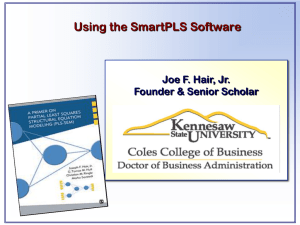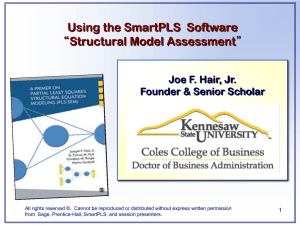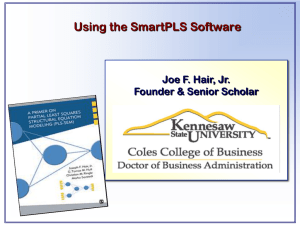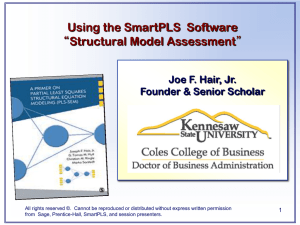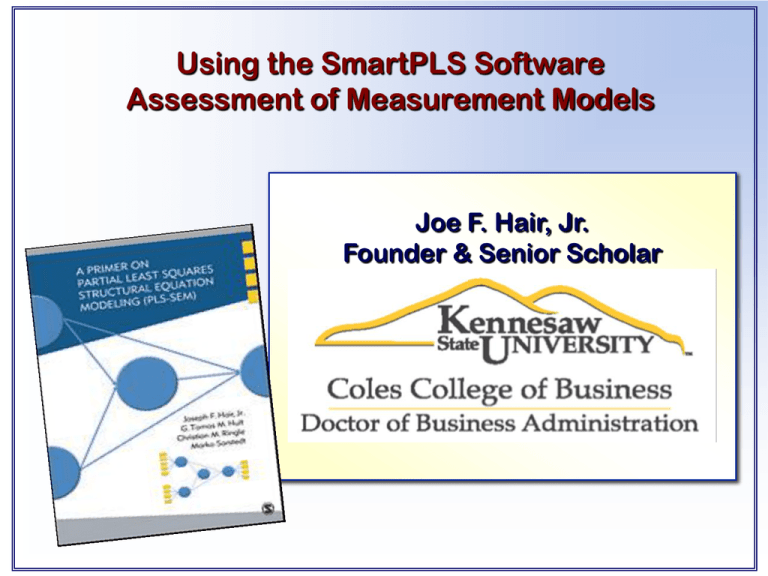
Using the SmartPLS Software
Assessment of Measurement Models
Joe F. Hair, Jr.
Founder & Senior Scholar
Indicators for SEM Model Exogenous Constructs
– Assessing Content Validity –
.
Assessing Formative Constructs and Indicators
Evaluating formative constructs and indicators involves the following:
1.First examine convergent validity using redundancy analysis. That is achieved by
correlating each formative construct with a global measure for that construct. The
construct is modeled as the independent variable and the global measure is the
dependent variable. A path coefficient above the threshold of 0.80 provides support
for convergent validity of the formative construct.
2.The next step is to examine the collinearity of the indicators. SmartPLS software
does not do this. SPSS or some other software must be used.
3.The third step is to examine the statistical significance of the outer weights (not
the loadings). This is done with the bootstrapping option of SmartPLS. Results for
our Corporate Reputation example indicate that all formative indicators are significant
except csor_2, csor_4, qual_2, and qual_4.
4.If any indicator weights are not statistically significant, then we examine the size
and significance of the indicator loadings. The SmartPLS default report provides
the outer loadings and t values. The lowest loading for the four non-significant
indicator weight is 0.57, and all t values are above 2.57, which indicates all four outer
loadings are significant (<0.01). Moreover, prior research and theory also provide
support for the relevance of these indicators for capturing the corporate social
responsibility and quality dimensions of corporate reputation. We therefore retain the
indicators in the formative constructs even though their outer weights are not
All rights reserved ©. Cannot be reproduced or distributed without express written
4
significant.
permission from Sage, Prentice-Hall, McGraw-Hill, SmartPLS, and session presenters.
Testing Convergent Validity – Formative Constructs
The next two slides show the findings of the redundancy
analysis for the four formative constructs in our SEM model.
The first model shows the results for the redundancy
analysis for the ATTR construct. The original formative construct is
labeled with ATTR_F, whereas the global assessment of the
company’s attractiveness using a single-item construct is labeled
with ATTR_G. As can be seen, this analysis yields a path coefficient
of 0.87, which is above the threshold of 0.80, thus providing support
for the formative construct’s convergent validity.
The redundancy analyses of the remaining formative
constructs (CSOR, PERF & QUAL) yield estimates of 0.86, 0.81,
and 0.81, respectively.
Thus, all formatively measured constructs have sufficient
degrees of convergent validity.
All rights reserved ©. Cannot be reproduced or distributed without express written
permission from Sage, Prentice-Hall, McGraw-Hill, SmartPLS, and session presenters.
5
All rights reserved ©. Cannot be reproduced or distributed without express written
permission from Sage, Prentice-Hall, McGraw-Hill, SmartPLS, and session presenters.
6
All rights reserved ©. Cannot be reproduced or distributed without express written
permission from Sage, Prentice-Hall, McGraw-Hill, SmartPLS, and session presenters.
7
Testing Collinearity of Indicators
The SmartPLS software does not provide users with the
tolerance and the VIF values. Statistical software packages such as
R, IBM SPSS Statistics, or Statistica, however, have collinearity
statistics in their linear regression modules. We will use the Full Data
file that has been converted to SPSS format. To convert, open the Full
Data.csv file with SPSS and use the Import Wizard (be sure to specify
that the top Row contains the variable names).
After converting the data file into SPSS format run a multiple
regression with the formative indicators of a specific formative
construct as independent variables and any other indicator, which is
not included in that specific measurement model, as the dependent
variable (otherwise, it does not matter which indicator serves as the
dependent variable).
With the exception of the collinearity analysis, the results of
the regression analysis do not matter and are not further analyzed.
The only result that is important for assessing collinearity issues is the
VIF (or tolerance) value.
All rights reserved ©. Cannot be reproduced or distributed without express written
permission from Sage, Prentice-Hall, McGraw-Hill, SmartPLS, and session presenters.
9
All rights reserved ©. Cannot be reproduced or distributed without express written
permission from Sage, Prentice-Hall, McGraw-Hill, SmartPLS, and session presenters.
10
This is the SPSS linear regression output.
The dependent variable is csor_1 and the
three independent variables are attr_, attr_2,
and attr_3. Note that all of the VIF
numbers are slightly above 1, and all well
below the threshold value of 5.
All rights reserved ©. Cannot be reproduced or distributed without express written
permission from Sage, Prentice-Hall, McGraw-Hill, SmartPLS, and session presenters.
11
Collinearity results for other formative construct
indicators are shown in Exhibit 5.22
All rights reserved ©. Cannot be reproduced or distributed without express written
permission from Sage, Prentice-Hall, McGraw-Hill, SmartPLS, and session presenters.
12
All rights reserved ©. Cannot be reproduced or distributed without express written
permission from Sage, Prentice-Hall, SmartPLS, and session presenters.
13
All rights reserved ©. Cannot be reproduced or distributed without express written
permission from Sage, Prentice-Hall, McGraw-Hill, SmartPLS, and session presenters.
14
All rights reserved ©. Cannot be reproduced or distributed without express written
permission from Sage, Prentice-Hall, McGraw-Hill, SmartPLS, and session presenters.
15
All rights reserved ©. Cannot be reproduced or distributed without express written
permission from Sage, Prentice-Hall, McGraw-Hill, SmartPLS, and session presenters.
16
Check to make sure correct
options are selected.
•No Sign Changes
•Correct number of cases =
sample size
•5,000 samples
All rights reserved ©. Cannot be reproduced or distributed without express written
permission from Sage, Prentice-Hall, McGraw-Hill, SmartPLS, and session presenters.
17
All rights reserved ©. Cannot be reproduced or distributed without express written
permission from Sage, Prentice-Hall, McGraw-Hill, SmartPLS, and session presenters.
18
All rights reserved ©. Cannot be reproduced or distributed without express written
permission from Sage, Prentice-Hall, McGraw-Hill, SmartPLS, and session presenters.
19
All rights reserved ©. Cannot be reproduced or distributed without express written
permission from Sage, Prentice-Hall, McGraw-Hill, SmartPLS, and session presenters.
20
Statistical Significance of Outer Weights
Formative Constructs
Based on the t statistics, all formative
indicators are significant except csor_2,
csor_4, qual_2, and qual_4.
All rights reserved ©. Cannot be reproduced or distributed without express written
permission from Sage, Prentice-Hall, McGraw-Hill, SmartPLS, and session presenters.
21
Checking Outer Loadings of non-significant
Formative Construct Indicators
The lowest outer loadings of
these four indicators are 0.5715
= csor_2 and 0.5667 = qual_2
(note: these values will change
slightly with bootstrapping), and
all t values are clearly above
2.57, which indicates the
significance of their outer
loadings (p < .01).
These results provide support
All rights reserved ©. Cannot be reproduced or distributed without express written
for retaining
these items.
permission from Sage, Prentice-Hall, McGraw-Hill, SmartPLS, and session presenters.
22
.
All rights reserved ©. Cannot be reproduced or distributed without express written
permission from Sage, Prentice-Hall, McGraw-Hill, SmartPLS, and session presenters.
24

